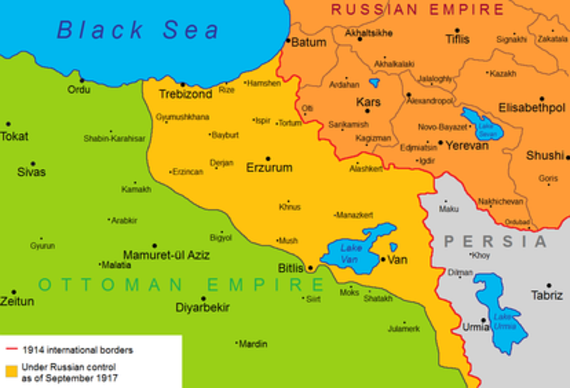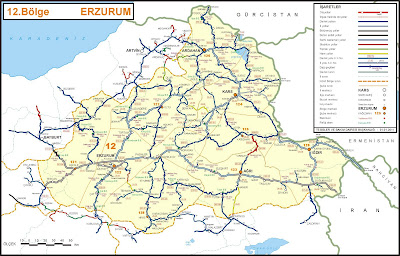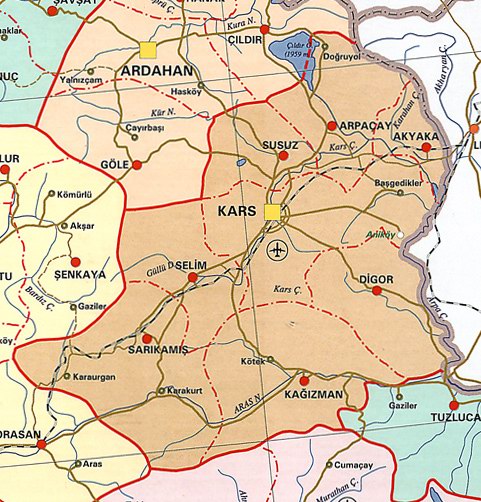between Turkish and Russian forces in December 1914,
our Iranian observer provides a thorough and insightful
assessment of the situation on both sides of the Caucasus
Front.//

Reasons for Turkish Maneuvers
If we study the Turkish – Russian border from the standpoint of
military strategy, meaning the implementation of a determined operation,
we see that the Erzurum – Kars – Tblisi road passes through the center
of the border that stretches from the Black Sea to Mt. Ararat. The Tblisi
– Kars railway runs along this same route, putting it 120 kilometers from
Erzurum and threatening the Turks’ most significant city in eastern
Anatolia and a place that is of critical importance to the Turkish military.
The Turkish border stretches from the west to Mt. Ararat. On Russian
territory or territory controlled by Russia the cities of Tblisi, Yerevan and
Tebriz lie along the rail line. The Turkish – Iranian border is formed by
the peaks of the Kurdistan mountain range. To the west of this border
there is mountainous Armenia, east of which there is the Azerbaijan
region where there are few Russians. The Azerbaijani people speak
Turkish (1) and are found near Ganja and Baku, which are Russian
Moslem provinces.
( 1)They cannot be called Turks. ((sic))
Looking at the situation and conditions, the Turkish General Staff had
three various options:
1 – Assemble south of Kars and attack Russian forces from this front,
while surrounding them from the north via Artvin and Ardahan. In this
way fortified Kars, which forms a major barrier along the route to Gümrü,
can be attacked from the rear and then passed en route to Gümrü.
Following the seizure of Gümrü, continue on to the fortified positions at
Mt. Bilağ and Mt. Nur Ahmed, east of Gümrü, before Russian forces
arrive.
The result of this plan would be the liberation of İranian Azerbaijan from
the Russian threat, as Russian communications would be cut off and its
influence in the east dramatically reduced. The Turkish Army would, as
well, be saved from a Russian attack on its homeland for some time to
come.
2 – Assemble the requisite forces on the Karakilise – Beyazid line for
defense of the Aras valley and move from here to the Yerevan –
Serdarabad area.
3 – Defend the entire Caucasus border and make a fierce attack on Şoşa
– Baku on the Azerbaijan side. However much advantage might be taken
from the excitement created among Azerbaijan and Caucasus Moslems
because of the call for cihad and the possible threat to the Baku oil fields
contained in this plan, accomplishing a maneuver like this in light of the
paucity of troops and the wait required for them, along with the
impossibility of resisting Russian counterattacks on the Kars – Erzurum
line and the wider front, made this plan completely inoperable. The
forces taken from the Turkish main contingent for such an operation on
the Russian – Iranian border, or further ahead, hampered by sick and
exhausted troops, would be facing enemy forces close to their main army
and ready for war with sufficient munitions.

Even the attack toward Serdarabad, which would give a quick result,
would be inoperable. For one thing, since the Turks did not have the
appropriate roads to reach this location they would be far away from their
operational starting point. In particular, the Russians would want to
threaten Sarıkamış and, by attacking the Turkish Army’s flank, draw
them away from here toward Mako and the Kurdistan mountains.
In accordance with these considerations, the first plan option was
accepted by the Turkish General Staff. For the accomplishment of this
plan the Turks had three army corps south of the border; the Ninth at
Erzurum, the Tenth at Erzincan and the Eleventh at Van. Three divisions
from each of these army corps, along with a cavalry division sent from
Istanbul at the beginning of September via Trabzon and Rize, and troops
from the Baghdad army corps and from Harput, formed the Third Army
under the direction of Izzet Paşa.
The first cavalry division was assembled at the Atina (Pazar) – Okum
location. The Ninth and Tenth army corps, which together formed the
core of the Third Army, were assembled at Hasankale as the military
units defending the Oltu and Aras valleys and a portion of the Eleventh
Army Corps was positioned at Erzurum in reserve.
Various forces were positioned in the Murad River valley and in the border
mountain peaks. A few battalions of “tribal cavalry divisions and border
and safety detachments”, along with some irregular forces were assigned
to attack Azerbaijan and to incite the Kurdish tribes to rebellion so that
they would obstruct the Russian advance on Van province.
Since there were insufficient forces in the Eleşkirt valley and at Beyazid,
and because it was deemed certain that the Russians would soon head
toward this valley, some elements of the Eleventh Army Corps were
assembled on the perimeter of Eleşkirt. These forces would facilitate the
movement of the main army toward Gümrü by cutting off Russian
communications and leaving them ineffective.
The elements of the First Army Corps assembled in the north were
charged with moving to Batum by sea from either side of the Lazistan
mountains, along the length of the Çürüksu valley.
Russians’ Operational Plan
The Russians’ plan was comprised exclusively of the following:
To be able to move a support force to Kars in a timely fashion and use
all existing and available forces at Kars for a rapid and effective attack
toward Erzurum in order to upset the assembly of the Turkish Army
and gain time.
Various detachments were assigned for this operation. Detachments
in the Oltucay valley were to threaten Turkish forces on the northern
flank and a cavalry detachment along the Aras River would seal off the
Köprukoy – Karakilise road. Subsequently, a detachment was to
enter the Murad River valley and head for Lake Van from Serdarabad.
Once arrived in Iranian territory the detachment would block any
Turkish entry, while at the same time inciting the many Armenians in
the area.
Batumi defenders were to remain at their garrison. Their duty being
limited to keep the Turks busy with a battle for the fortress there.

//End of Part II//

Hiç yorum yok:
Yorum Gönder